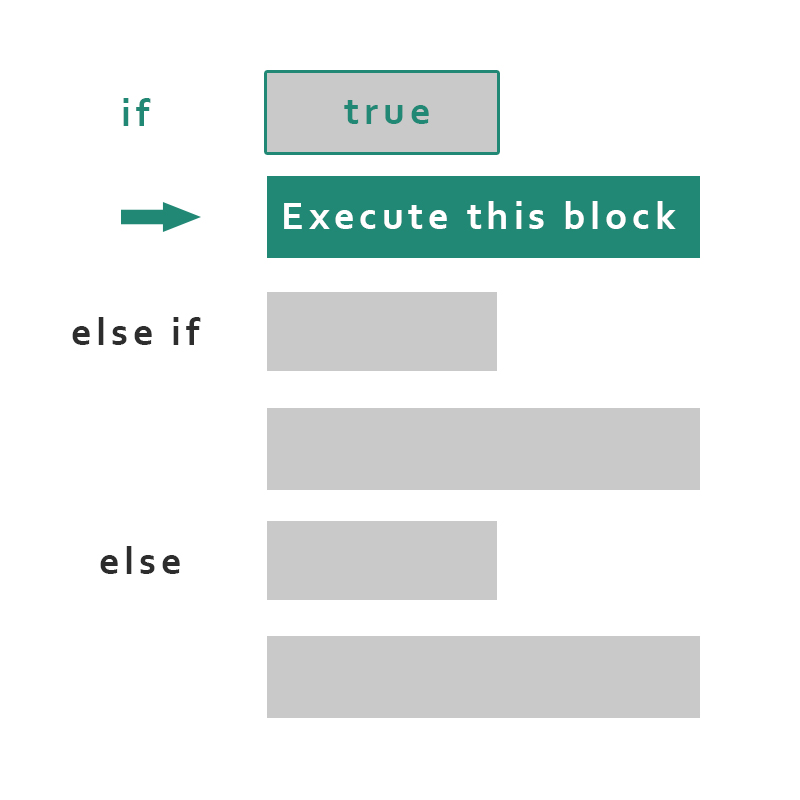The IF statement in PHP helps to see if a condition is true or not. If it is true, it makes the script do something different while it’s running.
The IF statement in PHP can be written like this:
if ( CONDITION ) {
... YOUR CODE HERE
}So, it runs the block of code inside the two curly braces if the main condition is met. However, if the condition is not true, it skips those commands.
Here is a figure that shows you the process of the “if” condition.

In the following sections, you will see other kinds of PHP IF condition. So let’s begin with the no curly braces.
IF Statement Without Curly Braces
When you write an ‘if’ statement in PHP, you can ignore the two curly braces; however, PHP will only execute one line of code, which is the line following the condition, or ignore it if the result is not true. Here is the syntax:
if ( CONDITION )
... THIS LINE WILL BE EXECUTED IF CONDITION IS TRUE So, writing multiple lines is not permitted—only one is allowed.
Let’s see an example:
$is_logged_in = false;
if ( $is_logged_in )
echo "Welcome Peter !"; // this is inside the if condition
echo "This line is not inside the condition";Let’s see another way for “if” condition in PHP.
Embedding IF Statements within HTML Markup
Imagine you’re writing a story on your website, but you want the story to change a bit if the reader is a kid. You could use an IF statement in your PHP code to do this magic trick. It’s like saying, “If the reader is a kid, show this friendly dragon picture. Otherwise, you can show another image by using else block”.
Here’s a simple way to do it:
$isKid = true;
if ($isKid) {
// If yes, show a friendly dragon picture
echo '<img src="friendly-dragon.jpg" alt="A Friendly Dragon">';
} You can also use the if(): and endif; constructs within HTML blocks. For example:
<?php if ($isKid): ?>
<img src="friendly-dragon.jpg" alt="A Friendly Dragon">
<?php endif; ?> In the following section, you will learn how to write if condition inside another if condition.
Nested IF Statement in PHP
The concept of nesting refers to placing one IF condition or more within another IF condition. here is an example
if ( true ) {
if( false ) {
echo "Nothing will print.";
}
}Anyway, in the following section, you will learn how variables operate depending on whether the condition is true or false.
Using Variables with IF Statements in PHP
Sometimes, you might want to give a new value to a variable when certain conditions are met. If the condition is true, the variable gets this new value. Let’s look at an example to make it clearer.
if ( true ) {
$username = "Mohammed";
}
echo $username;But what happens if the condition turns out to be false? To answer this question, you need to look at the following example. As it produces an error because the variable is not defined if the PHP interpreter skips the line inside the condition.
if ( false ) {
$username = "Peter";
}
echo $username;This will show you the following error message.
PHP Warning: Undefined variable $username in /workspace/Main.php on line 6
Anyway let’s see more examples to gain a deeper understanding.
Examples
Here, we’ll check if a number is positive. If the condition is true, a message will be displayed.
$number = 5;
if ($number > 0) {
echo "The number is positive.";
}You can also nest if statements within each other to check multiple conditions in a more detailed manner.
$day = "Monday";
$weather = "Sunny";
if ($day == "Monday") {
if ($weather == "Sunny") {
echo "It's a sunny Monday!";
}
} Let’s summarize it in a few points.
Wrapping Up
The IF statement in PHP checks whether a condition is true, allowing the script to perform different actions based on this check. Here’s a concise summary of the key points discussed:
- The IF statement evaluates a condition. If the condition is true, it executes the code block within the curly braces
{}. If the condition is false, the code block is skipped. - For a single-line condition, PHP allows an IF statement without curly braces, executing only the immediate line following the condition if it’s true.
- IF statements can dynamically change HTML content, such as displaying different images based on conditions. This is useful for personalizing web pages based on user data or preferences.
- You can place IF statements within other IF statements to create complex decision trees.
Thank you for reading. Happy Coding!